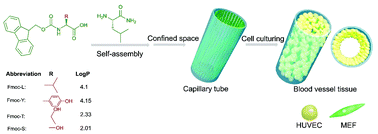Self-assembly of Fmoc-amino acids in capillary confined space forming a parallel ordered fiber network for application in vascularization†
Abstract
Matrices formed by self-assembly of amino acids and their derivatives are suitable for cell spreading, migration and proliferation, and widely used in tissue engineering and organ regeneration, due to the biological endogenous molecules and weak intermolecular forces. The self-assembly process is not only affected by dynamic and thermodynamic factors, but also the assembled space. In this work, capillary tubes with different diameters are chosen to mimic a confined environment and the effect of capillary space on the self-assembly behavior of Fmoc-amino acids with different oil–water partition coefficients (log P) was investigated. The amino acids can form special morphologies and structures through the limitation of the Brownian motion and the template effect exerted by a confined environment. Meanwhile, the obtained parallel ordered fiber network was applied to mimic the extracellular matrix (ECM) and support the adhesion and proliferation of monolayer flat epithelial cells (HUVECs). We believe that the exploration of the self-assembly of amino acids in confined space can promote the understanding of the supramolecular self-assembly mechanism and offer a great opportunity in building the specific structures of vessels or tissues in vitro.

- This article is part of the themed collection: Biomaterials Science Recent HOT Articles


 Please wait while we load your content...
Please wait while we load your content...